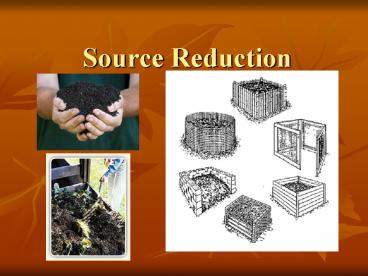Source Reduction - PowerPoint PPT Presentation
1 / 26
Title: Source Reduction
1
Source Reduction
2
Presentation 5The Composting Toolkit
- Funded by the Indiana Department of Environmental
Management Recycling Grants Program - Developed by the Indiana Rural Community
Assistance Program - RCAP
3
Source ReductionIn The Realm Of Composting
- Source reduction programs are those activities
which allow yard waste to remain at its
generation site without entering the waste
stream. - Examples
- Leaving grass clippings lie
- Backyard composting
- Home made mulch and brush piles
4
Documented Benefits
- The United States Composting Council looked into
the effectiveness of backyard composting
education programs across the county. - They found
- Communities that invested in home composting
education realized measurable savings in the
costs of waste disposal - For an investment on average of 12/ton directly
tied to backyard composting education communities
saved an average of 56/ton in disposal costs for
a net average savings of 44/ton.
5
Leave It A Lawn!
- It has many names . . .
- Grasscycling
- Mulching Mower
- Dont Bag It
- Leave It Lay
- They all come down to one simple concept leave
your grass clippings on your lawn.
6
Leave It A Lawn!
- Just leave grass clippings on the lawn instead of
collecting them. - As the grass clippings decompose they release
nitrogen, phosphorus, and potassium back into the
soil, so less fertilizer is needed. - The lawn will also need less water because the
grass clippings tend to reduce evaporation.
7
Leave It A Lawn!
- No Bags
- Less Water
- Less Fertilizer
- Saves Money
8
Backyard Composting
- Low tech.
- Lowest energy costs because the compost is
treated at the location where it was created. - Many styles of bins. The key, however, is not
the bin but maintaining optimal conditions. - Backyard composting is considered SOURCE
REDUCTION by the EPA hierarchy of waste
management.
9
Backyard Composting
- Home composting takes the waste disposal problem
and stops it at its source. It reduces the
amount of waste that municipalities need to
collect as part of their municipal composting
programs. By avoiding collection and processing
costs, home composting represents the lowest cost
management alternative.
10
Backyard Composter
- To say there is a variety of shapes and types of
backyard composters would be a huge
understatement. - They all, however, serve a similar purpose
facilitate the composting process while keeping
the materials that are composting within a tidy
space. - The following slides are a sampling of the many
varieties of home composter.
11
Tumbler Composters
12
Multi-chamber Bins
13
Wire or Enclosure Composter
14
Cinder Block Bins
15
Pallet Composters
16
Prefabricated Bins(Examples, Not Endorsements)
17
And More Prefabricated Bins(And In No Particular
Order)
18
And A Few Other . . .(Youre getting the idea,
right?)
19
Backyard Composters
- Regardless of the type of composter you choose,
they should have a few key elements - Be sure the bin you select is well-ventilated.
Good air circulation is key to successful
composting. - The ideally sized structure should be
approximately 3 feet x 3 feet x 3 feet. - The pitfall of smaller is it may not heat
properly - The pitfall of larger is you may not have enough
air circulation - Placement is as important as the bin. Put it
somewhere in the yard where it will get a blend
of direct sunlight and shade time. - Remember that maintaining ideal composting
conditions (moisture, carbon-to-nitrogen ratio,
proper turning/aeration) is every bit (okay, its
more important) than the bin itself.
20
Ideal Composting Conditions
- Particle size ? smaller better
- Moisture ? 40-60
- Temp. ? 90-140 degrees F
- Oxygen ? gt5
- Carbon to Nitrogen Ratio ? 301
- Also Called Brown/Green or C/N Ratio
21
Compost Trouble Shooting
- Symptom has bad odor ? Problem not enough air ?
Solution turn pile daily until odor is gone - Symptom center of pile is dry ? Problem not
enough water ? Solution moisten material while
turning pile - Symptom compost is damp and warm ? Problem pile
too small ? Solution collect more material and
mix the pile in the middle but nowhere else - Symptom the pile will not heat up ? Problem
lack of nitrogen ? Solution mix in a nitrogen
source such as grass clippings, fresh manure, or
fertilizer
22
Other Home Source Reduction
- Home made mulch
- There are a number of small chippers and
shredders on the market that allow people to make
their own mulch out of trimmings from their yard. - In some gardening situations grass clippings or
leaf litter can also be used as mulches. - Home made brush piles
- These can be attractive and provide animal
habitat. Make sure they are not a violation of
local neighborhood covenants or ordinance.
23
Worm Composting
- Can be done indoors or outdoors
- Uses the macro-organism, red worms, verses the
micro-organisms used in other forms of composting - Most effective with vegetable matter food wastes
- Can be very small or very large scale
24
Worm Composters
25
QUESTIONS?
26
Thank You!
- Additional Questions, Comments, or You Think You
Have A Potential Pilot Community - Please Feel Free to Contact Me
- Mark W. Davis
- Technical Assistance Provider
- Rural Community Assistance Program
- Office 1-800-382-9895
- Wireless (812) 320-0720
- E-mail mdavis_at_incap.org

